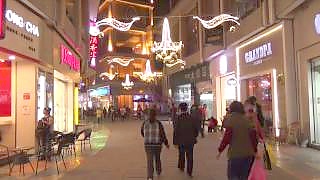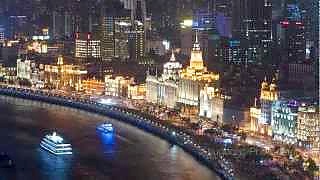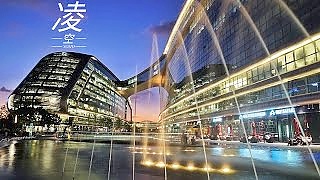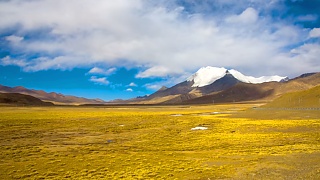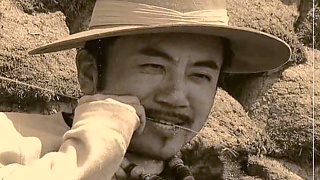With Little Journey ...
[640],shadow=true,start=,stop=Bonus film - the Expo Culture Park ...
New World City, located to the west of Nanjing Road pedestrian street.
The New World area in Shanghai is a vibrant and bustling commercial and entertainment district located in the Huangpu District, one of the city's most central and historic areas. Here are some key highlights and features of the New World area:
### 1. **Shopping and Retail**
- **New World City Mall**: This is one of the prominent shopping malls in the area, offering a wide variety of local and international brands. It has multiple floors with fashion, electronics, and lifestyle stores, catering to diverse shopping needs.
- **Nanjing Road**: Adjacent to the New World area, Nanjing Road is one of the world's busiest shopping streets, lined with large department stores, specialty shops, and boutiques.
### 2. **Dining and Entertainment**
- **Restaurants and Cafes**: The area is home to numerous dining options ranging from upscale restaurants to casual cafes. Visitors can enjoy a variety of cuisines including traditional Chinese, Asian fusion, and Western dishes.
- **Entertainment Venues**: The New World area features various entertainment options such as cinemas, karaoke bars, and live performance venues. The Shanghai Grand Theatre and the Lyceum Theatre are notable nearby cultural spots offering a range of performances including plays, musicals, and concerts.
### 3. **Tourist Attractions**
- **People's Square**: Located close to the New World area, People's Square is a major public square and a central hub for cultural and social activities. It houses the Shanghai Museum, Shanghai Urban Planning Exhibition Hall, and the People's Park.
- **Madame Tussauds Shanghai**: This famous wax museum is a popular attraction where visitors can see lifelike wax figures of celebrities, historical figures, and cultural icons.
### 4. **Transportation**
- **Metro Access**: The New World area is well-connected by Shanghai's extensive metro system. People's Square Station, which is one of the busiest interchange stations, serves lines 1, 2, and 8, providing easy access to other parts of the city.
- **Road Networks**: The area is also accessible by various bus routes and taxis, making it convenient for both locals and tourists to reach.
### 5. **Cultural and Historic Significance**
- **Historic Architecture**: The area around New World features a mix of modern and historic architecture, reflecting Shanghai's rich cultural heritage and rapid modernization.
- **Local Culture**: Visitors can experience the local culture through street performances, traditional markets, and seasonal festivals that often take place in and around the New World area.
Overall, the New World area in Shanghai is a dynamic and multifaceted district that offers a blend of shopping, dining, entertainment, and cultural experiences, making it a must-visit for anyone exploring the city.
Expo Culture Park, also known as Shanghai Expo Culture Park, is a significant green space and cultural area located in the Pudong District of Shanghai. Developed on the former site of the 2010 Shanghai World Expo, the park is designed to be a major urban green space and cultural landmark. Here are some key features and highlights of Expo Culture Park:
### 1. **Green Spaces and Natural Scenery**
- **Large Green Areas**: The park features extensive green spaces, including lawns, gardens, and tree-lined paths. It's designed to provide a natural retreat within the urban environment.
- **Floral Displays**: Various sections of the park are dedicated to flower gardens and seasonal floral displays, offering vibrant colors and scents throughout the year.
### 2. **Cultural and Artistic Installations**
- **Public Art**: The park is home to numerous public art installations and sculptures, contributing to its cultural atmosphere. These works often reflect themes related to nature, urban life, and the legacy of the Expo.
- **Exhibition Halls**: There are exhibition spaces within the park where cultural events, art exhibitions, and community activities are regularly held.
### 3. **Recreational Facilities**
- **Walking and Cycling Paths**: The park has well-maintained paths for walking, jogging, and cycling, making it a popular spot for outdoor exercise.
- **Children's Play Areas**: Designated areas with playgrounds and interactive installations cater to families with children, offering safe and engaging environments for play.
### 4. **Water Features**
- **Lakes and Waterways**: The park includes several artificial lakes and waterways, adding to the scenic beauty and providing habitats for local wildlife.
- **Boating**: Visitors can often rent boats to explore the lakes, enjoying a peaceful activity amidst the urban setting.
### 5. **Theater and Performance Venues**
- **Open-Air Theaters**: The park includes open-air theaters and performance spaces where concerts, theatrical performances, and cultural festivals are held.
- **Music and Dance Performances**: Regularly scheduled performances and events showcase both traditional and contemporary music and dance, drawing both locals and tourists.
### 6. **Environmental Sustainability**
- **Eco-Friendly Design**: The park is designed with sustainability in mind, incorporating green building practices, renewable energy sources, and water conservation measures.
- **Biodiversity Conservation**: Efforts are made to preserve and enhance local biodiversity, with native plant species and habitats integrated into the park's design.
### 7. **Historical Significance**
- **Legacy of the Expo**: As the site of the 2010 Shanghai World Expo, the park retains elements that commemorate the event, including some of the original pavilions and structures that have been repurposed for cultural and recreational use.
### 8. **Accessibility**
- **Transportation**: The park is easily accessible via public transportation, including metro lines and buses. It’s located in a well-connected area of Pudong, making it convenient for visitors from across the city.
- **Visitor Facilities**: The park is equipped with visitor centers, restrooms, and dining options, ensuring a comfortable experience for guests.
Expo Culture Park serves as a significant cultural and recreational hub in Shanghai, providing a blend of natural beauty, cultural enrichment, and historical significance. It’s a prime example of urban renewal, transforming the legacy of the Expo into a lasting public asset for the city.
Shanghai is one of China's most dynamic and cosmopolitan cities, blending a rich history with modern skyscrapers and vibrant culture. Here's what you need to know as a tourist visiting Shanghai:
Historical and Cultural Landmarks:
The Bund: This iconic waterfront promenade along the Huangpu River features colonial-era buildings on one side and futuristic skyscrapers on the other, offering stunning views of Shanghai's skyline.
Yu Garden: Dating back to the Ming dynasty, Yu Garden is a classical Chinese garden with pavilions, ponds, and rockeries. The nearby Yu Garden Bazaar is a great place to shop for souvenirs and traditional crafts.
Shanghai Museum: Home to an extensive collection of Chinese art and artifacts, including bronzes, ceramics, paintings, and calligraphy, the Shanghai Museum is a must-visit for history and art enthusiasts.
Jing'an Temple: One of Shanghai's most famous Buddhist temples, Jing'an Temple is known for its beautiful architecture, peaceful atmosphere, and towering golden Buddha statue.
Modern Attractions:
Shanghai Tower: Ascend to the observation deck of this iconic skyscraper, the tallest in China and the second-tallest in the world, for panoramic views of the city.
The Oriental Pearl TV Tower: Another iconic landmark, this futuristic tower offers observation decks, a glass-bottomed skywalk, and a revolving restaurant.
Shanghai Disneyland: Located in the Pudong district, Shanghai Disneyland offers a magical experience for visitors of all ages with its themed lands, attractions, and entertainment.
Shopping and Entertainment:
Nanjing Road: One of the world's busiest shopping streets, Nanjing Road is lined with department stores, boutiques, and restaurants. Don't miss the nearby pedestrian-friendly Nanjing Road East, known for its lively atmosphere and street performers.
Xintiandi: This upscale shopping, dining, and entertainment district features a mix of traditional Shikumen-style buildings and modern amenities, making it a popular destination for locals and tourists alike.
French Concession: Explore this historic neighborhood known for its tree-lined streets, charming cafes, boutiques, and art galleries.
Culinary Delights:
Shanghai Cuisine: Sample local specialties such as xiaolongbao (soup dumplings), shengjianbao (pan-fried dumplings), and Shanghai-style noodles.
Street Food: Wander through the city's bustling food markets and snack streets to taste a variety of street foods, from savory pancakes to grilled skewers.
Practical Tips:
Transportation: Shanghai has an efficient public transportation system, including the subway, buses, and taxis. Consider purchasing a rechargeable transportation card for convenience.
Language: While Mandarin is the official language, English is widely spoken in tourist areas, hotels, and restaurants.
Weather: Shanghai experiences four distinct seasons, with hot, humid summers and chilly winters. The best times to visit are spring (March to May) and autumn (September to November) when the weather is mild and comfortable.
Etiquette: Respect local customs and traditions, such as using polite language and avoiding loud behavior in public places.
Shanghai offers a captivating blend of old and new, with its historic landmarks, modern skyscrapers, vibrant culture, and delectable cuisine. Whether you're interested in history, architecture, shopping, or dining, Shanghai has something to offer every type of visitor.
 A quick walk around the New World area of central ShangHai, plus the Expo Culture Park
A quick walk around the New World area of central ShangHai, plus the Expo Culture Park